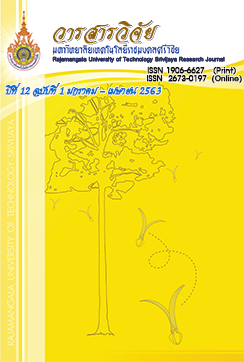การวิเคราะห์เครือข่ายอนุรักษ์หอยปะในลุ่มน้ำปะเหลียน จังหวัดตรัง
คำสำคัญ:
การวิเคราะห์เครือข่ายทางสังคม, การอนุรักษ์, หอยปะ, ตรัง, ลุ่มน้ำปะเหลียนบทคัดย่อ
การศึกษานี้มีวัตถุ ประสงค์เพื่อวิเคราะห์เครือข่ายอนุรักษ์หอยปะในลุ่มน้ำปะเหลียน เป็นการวิจัยแบบผสานวิธี (Mixed method) ทั้งเชิงคุณภาพและเชิงปริมาณ กลุ่มเป้าหมายเป็นสมาชิกเครือข่ายอนุรักษ์หอยปะใน 2 ชุมชน คือ บ้านหินคอกควาย และบ้านทุ่งตะเซะ จำนวน 34 และ 39 คน ตามลำดับ เครื่องมือที่ใช้ในการวิจัยเป็นแบบสอบถาม ตรวจสอบคุณภาพเครื่องมือวิจัยโดยผู้เชี่ยวชาญ 3 คน มีค่าเฉลี่ยดัชนีความสอดคล้อง (IOC=0.67-1.00) โครงสร้างความสัมพันธ์ของสมาชิกเครือข่ายอนุรักษ์หอยปะได้ทดสอบผลต่างของค่าความเป็นศูนย์กลาง ด้วย Permutation t-test พบว่า เครือข่ายอนุรักษ์หอยปะบ้านหินคอกควาย และเครือข่ายอนุรักษ์หอยปะและป่าชายเลนบ้านทุ่งตะเซะ มีค่า degree centrality (mean =0.651 และ 0.676 ตามลำดับ) ค่า betweenness centrality (mean=0.011 และ 0.009 ตามลำดับ) และค่า closeness centrality (mean=0.749 และ 0.775 ตามลำดับ) ไม่มีความแตกต่างกันที่ระดับนัยสำคัญ 0.05 (p-value=0.62, 0.37 และ 0.32 ตามลำดับ) แสดงว่า สมาชิกของแต่ละเครือข่ายมีกิจกรรมการติดต่อสื่อสารพูดคุยเรื่องข้อมูลข่าวสารในประเด็นต่างๆ ที่เกี่ยวกับการอนุรักษ์หอยปะในระดับที่ไม่แตกต่างกัน รวมถึงทั้ง 2 เครือข่าย มี node ที่เป็นตัวผ่านในการติดต่อสื่อสารระหว่าง node แต่ละคู่นั้นเป็นตัวกระจายข้อมูลข่าวสารและสามารถควบคุมการติดต่อสื่อสารภายในเครือข่ายได้ในระดับที่ไม่แตกต่างกัน นอกจากนี้มี node ที่สามารถติดต่อสื่อสารกับ node อื่นๆ ที่เหลือในเครือข่ายได้อย่างรวดเร็วและมีประสิทธิภาพในระดับที่ไม่แตกต่างกัน ทั้งนี้สมาชิกเครือข่ายที่มีกิจกรรมการติดต่อสื่อสารมาก และมีอิทธิพลในการควบคุมการไหลของข้อมูลข่าวสารภายในเครือข่ายสูง สำหรับเครือข่ายอนุรักษ์หอยปะบ้านหินคอกควาย คือ H7, H2, H14 โดย H7 เพศหญิง เป็น เครือข่ายสูง สำหรับเครือข่ายอนุรักษ์หอยปะบ้านหินคอกควาย คือ H7, H2, H14 โดย H7 เพศหญิง เป็นเลขานุการ มีบทบาทในการติดต่อประสานงานกับสมาชิกเครือข่ายทุกคน จดบันทึกการประชุม และร่วมทำกิจกรรมของเครือข่าย H2 เพศชาย เป็นประธานเครือข่ายที่เป็นทางการ (ผู้ใหญ่บ้าน) มีบทบาทในการกำหนดแนวทางการอนุรักษ์หอยปะ จัดหางบประมาณใช้ในการอนุรักษ์หอยปะ เฝ้าระวังหอยปะไม่ให้เรือเข้ามาคราดหอยปะในเขตอนุรักษ์ H14 เพศชาย เป็นกรรมการที่มีส่วนร่วมในกิจกรรมของเครือข่าย ส่วนเครือข่ายอนุรักษ์หอยปะและป่าชายเลนบ้านทุ่งตะเซะ คือ T1, T33, T34, T32 โดย T1 เพศชาย เป็นประธานเครือข่ายแบบธรรมชาติ (อดีตผู้ใหญ่บ้าน) มีบทบาทในการวางแนวทางการอนุรักษ์หอยปะและป่าชายเลน จัดหางบประมาณทำศูนย์อนุรักษ์หอยปะ ทำถนนเข้าศูนย์ฯ และประสานกับภาครัฐในระดับตำบล รวมถึงระดับอำเภอ และจังหวัด เมื่อเกิดความขัดแย้งที่เรือของชุมชนใกล้เคียงเข้ามาคราดหอยปะในเขตอนุรักษ์ T33 เพศชาย เป็นที่ปรึกษา มีบทบาทในการจัดกิจกรรมปลูกป่าชายเลนให้กับบุคคลภายนอกที่เข้ามาศึกษาระบบนิเวศป่าชายเลน T34 เพศชาย เป็นสมาชิกสภาเทศบาล T32 เพศหญิง ทั้ง T34 และ T32 เป็นกรรมการที่มีส่วนร่วมในกิจกรรมของเครือข่าย
เอกสารอ้างอิง
ปุสตี มอนซอน, สกรรจ์ พรหมศิริ, ญาณีกรณ์ ธรรมโชติ และ ดลทิพย์ พืชผลเจริญ. 2547. กรอบแนวคิดการประเมินศักยภาพเครือข่ายสังคม. คณะสังคมศาสตร์และมนุษยศาสตร์, มหาวิทยาลัยมหิดล.
ประภาพรรณ อุ่นอบ. 2552. เครือข่ายกลไกสำคัญในการขับเคลื่อนงานพัฒนาอย่างบูรณาการเชิงพื้นที่. เอส พีกราฟฟิค พรีเพรส พริ้นติ้ง, กรุงเทพฯ.
พิมาลา เกษมสุข. 2560. การวิเคราะห์เครือข่ายทางสังคมของการผลิตเป็ดไล่ทุ่งในพื้นที่ภาคกลางและภาคตะวันตกของประเทศไทย. ปริญญาวิทยาศาสตรมหาบัณฑิต สาขาระบาดวิทยาทางสัตวแพทย์, มหาวิทยาลัยเกษตรศาสตร์.
พิมาลา เกษมสุข. 2560. การวิเคราะห์เครือข่ายทางสังคมของการผลิตเป็ดไล่ทุ่งในพื้นที่ภาคกลางและภาคตะวันตกของประเทศไทย. วิทยานิพนธ์ปริญญาวิทยาศาสตรมหาบัณฑิต สาขาระบาดวิทยาทางสัตวแพทย์, มหาวิทยาลัยเกษตรศาสตร์. อ้างถึง Hanneman, R.A. and Riddle, M. 2005. Introduction to Social Network Methods. Available Source: http://faculty.ucr.edu/~hanneman/nettext/, October 10, 2015.
พิมาลา เกษมสุข. 2560 . การวิเคราะห์เครือข่ายทางสังคมของการผลิตเป็ดไล่ทุ่งในพื้นที่ภาคกลางและภาคตะวันตกของประเทศไทย. วิทยานิพนธ์ปริญญาวิทยาศาสตรมหาบัณฑิต สาขาระบาดวิทยาทางสัตวแพทย์, มหาวิทยาลัยเกษตรศาสตร์. อ้างถึง Martinez-Lopez, B., Perez, A.M. and Sanchez-Vizcaino, J.M. 2009. Social network analysis. Review of general concepts and use in preventive veterinary medicine. Transboundary and Emerging Diseases 56(4): 109-120.
Arabshahi, M. and Pérez-Chiqués, E. n.d. Centrality and Centralization. Available Source: www.albany.edu/faculty/kretheme/PAD637/ClassNotes/Spring%202013/Slides5.pdf, June 17, 2018.
Cecil, C. 2014. Factors influencing collaboration toward cetacean and sea turtle conservation in the Adriatic Sea. Master of Conservation Science, Imperial College London.
Cecil, C. 2014. Factors influencing collaboration toward cetacean and sea turtle conservation in the Adriatic Sea. Master of Conservation Science, Imperial College London. Cited Prell, C., Hubacek, K. and Reed, M. 2009. Stakeholder Analysis and Social Network Analysis in Natural Resource Management. Society & Natural Resources 22(6): 501-518.
Hanneman, R.A. and Riddle, M. n.d. Introduction to social network methods. Available Source: http://faculty.ucr.edu/~hanneman/nettext/, January 22, 1960.
Jayawickrema, E.M. and Wijeyaratne, M.J.S. 2009. Distribution and population dynamics of the edible bivalve species Meretrix casta (Chemnitz) in the Dutch canal of Sri Lanka. Sri Lanka Association for Fisheries and Aquatic Resources 14: 29-44.
Laxmilatha, P., Thomas, S., Sivadasan, M.P., Ramachanran, N.P. and Surendranathan, V.G. 2006. The fishery and biology of Meretrix casta (Chemnitz) in the Moorad estuary, Kerala. Indian Journal of Fisheries 53(1): 109-113.
Laxmilatha, P. 2013. Population dynamics of the edible clam Meretrix casta (Chemnitz) (International Union for Conservation of Nature status: Vulnerable) from two estuaries of North Kerala, southwest coast of India. International Journal of Fisheries and Aquaculture 5(10): 253-261.
Luna, M.A. 2014. Looking Beyond the Fisherwoman: A Case Study of Women’s Empowerment in Marine Resour Luna Management and Policy. Master of Marine Affairs, University of Washington.
Pietri, D.M. 2015. Social Capital in Marine Management Collaborative Networks: Lessons Learned in the Coral Triangle and the Philippines. Doctor of Philosophy, School of Environmental and Forest Sciences, University of Washington.
Porse, E. and Lund, J. 2015. Network structure, complexity, and adaptation in water resource systems. Civil Engineering and Environmental Systems 32(1-2): 143-156.
Ricke, A.M. 2009. Networks and Co-management in Small-scale Fisheries in Chile. Master of Natural Resources Management, University of Manitoba. Cited Bodin, Ö. 2006. A network perspective on ecosystems, societies and natural resource management. Doctoral Thesis in Natural Resource Management, Stockholm University.
Ricke, A. M. 2009. Networks and Co-management in Small-scale Fisheries in Chile. Master of Natural Resources Management, University of Manitoba. Cited Carlsson, L. and Sandström, A. 2008. Network governance of the commons. International Journal of the Commons 2(1): 33-54.
Ricke, A.M. 2009. Networks and Co-management in Small-scale Fisheries in Chile. Master of Natural Resources Management, University of Manitoba. Cited Faust, K. 1997. Centrality in affiliation networks. Social Networks 19: 157-191.
Ricke, A.M. 2009. Networks and Co-management in Small-scale Fisheries in Chile. Master of Natural Resources Management, University of Manitoba. Cited Hanneman, R.A. and Riddle, M. 2005. Introduction to social network methods. Riverside, CA: University of California, Riverside. Retrieved. Available Source: http://faculty.ucr.edu/ ~hanneman/, January 7, 2008.
Springer, A.C. and de Steiguer, J.E. 2011. Social Network Analysis: A Tool to Improve Understanding of Collaborative Management. Journal of Extension 49(6): 1-8.
Tanyaros, S. and Tongnunui, P. 2011. Influence of environmental variables on the abundance of estuarine clam Meretrix casta (Chemnitz, 1782) in Trang Province, Southern Thailand. Songklanakarin Journal of Science and Technology 33(1): 107-115.
Thongphubate, T. and Piekkoontod, T. 2016. Social network analysis on mangrove ecosystem management of Welu Basin, Thailand. Songklanakarin Journal of Science and Technology 38(3): 243-248. Cited Burt, R.S. 1992. Structural Holes. Cambridge University Press, New York, U.S.A.
Turner, R.A., Polunin, N.V.C. and Stead, S.M. 2014. Social Networks and Fishers’ Behavior: Exploring the Links between Information Flow and fishing Success in the Northumberland lobster fishery. Ecology and Society 19(2): 38.
Turner, R.A., Polunin, N.V.C. and Stead, S.M. 2014. Social networks and fishers’ behavior: exploring the links between information flow and fishing success in the Northumberland lobster fishery. Ecology and Society 19(2): 38. Cited Scott, J. 2000. Social network analysis: a handbook. Sage, London, UK.
Worranut, P., Boonyawiwat, V., Kasornchandra, J. and Poolkhet, C. 2018. Analysis of a shrimp farming network during an outbreak of white spot disease in Rayong Province, Thailand. Aquaculture 491: 325-332.
ดาวน์โหลด
เผยแพร่แล้ว
รูปแบบการอ้างอิง
ฉบับ
ประเภทบทความ
สัญญาอนุญาต
เนื้อหาและข้อมูลในบทความที่ลงตีพิมพ์ในวารสารวิจัยมหาวิทยาลัยเทคโนโลยีราชมงคลศรีวิชัย ถือเป็นข้อคิดเห็นและความรับผิดชอบของผู้เขียนบทความโดยตรง ซึ่งกองบรรณาธิการวารสารไม่จำเป็น ต้องเห็นด้วย หรือร่วมรับผิดชอบใดๆ
บทความ ข้อมูล เนื้อหา รูปภาพฯลฯ ที่ได้รับการตีพิมพ์ในวารสารวิจัย มหาวิทยาลัยเทคโนโลยีราชมงคลศรีวิชัย ถือเป็นลิขสิทธ์ของวารสารวิจัย มหาวิทยาลัยเทคโนโลยีราชมงคลศรีวิชัย หากบุคคลหรือหน่วยงานใดต้องการนำทั้งหมดหรือส่วนหนึ่งส่วนใดไปเผยแพร่ต่อหรือเพื่อการกระทำการใดๆจะต้องได้รับอนุญาตเป็นลายลักษ์อักษรจากวารสาร มหาวิทยาลัยเทคโนโลยีราชมงคลศรีวิชัยก่อนเท่านั้น







